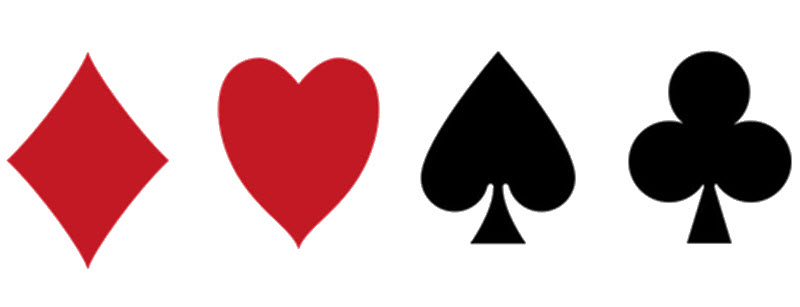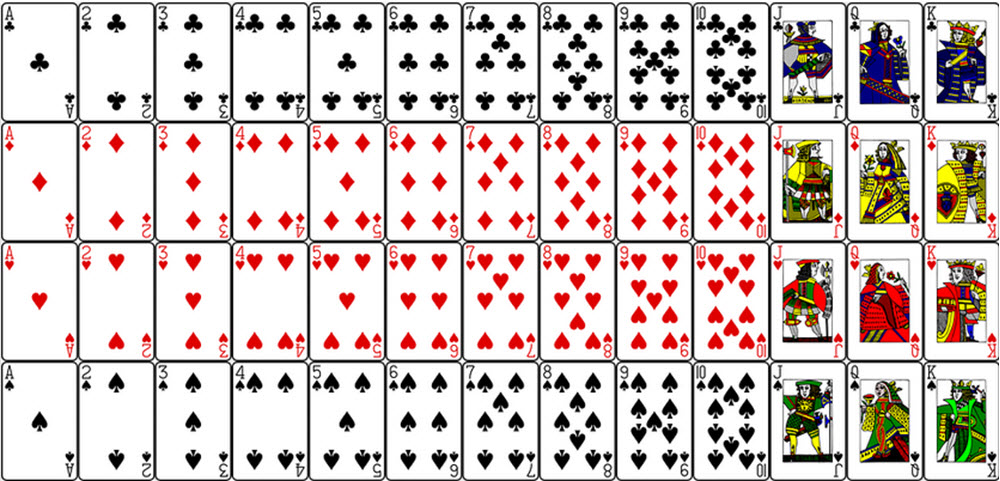Learning the basics
Contract bridge, often known simply as bridge, is a strategic card-game played by four participants who form two opposing partnerships.
The deck
Bridge is played with a standard 52-card deck. No jokers or other wild cards are used.

Partnerships
The players sitting across from each other at the table form partnerships: the North-South partnership and the East-West partnership.
The deals
In bridge, each deal consists of three parts:
- The auction. The four players bid in a clockwise rotation.
- The play. The side that won the bidding auction tries to take enough tricks to complete their contract.
- The scoring
What´s a trick?
A trick consists one card from each player, played in clockwise order.
Bidding
Bidding is an essential part of bridge, where you try to inform your partner about the strengths and weaknesses of your hand.
A bid has two parts: a number + a suit (spades / hearts / diamonds / clubs / notrump)
Example: A 1 heart bid = the pair intends to take six tricks plus one (seven tricks in total) with hearts as the trump suit. Six is always the base, so the number is added on top of six.
The suits are of different value, with clubs being the lowest. Notrump is worth more than any of the suits.
The bidding – this is how it´s done:
- The dealer starts by either bidding or passing.
- The auction proceeds around the table clockwise, with each player bidding or passing.
- The auction stops when three players in a row say pass instead of bidding. At this point, the last bid becomes the contract. The player who made this bid has now contracted themselves and their partner to, as a team, take that number of tricks. Example: 2 heart bid = 8 tricks with hearts as trump.
The Declarer and the Dummy
- The first player at the table who mentions the suit (or notrump) that becomes the final contract becomes the declarer.
- The person sitting left of the declarer makes the opening lead, by playing one card face-up. This person is the opening leader.
- The partner of the declarer is the dummy and must place their hand face-up on the table. From now, the dummy is just an observer, while the declarer plays the cards from their own hand and the dummy hand.
Fulfilling the contract
A pair fulfils their contract by winning at least as many tricks as stipulated by the contract. So, winning more tricks than the contract is fine, but winning fewer is not.
If the pair wins fewer tricks than the contract, there is a penalty.
How are the cards dealt?
- The four players draw cards to determine who will be the dealer.
- The dealer distributes cards to all four players, one at a time, in a clockwise rotation. Every card is dealt face down. The whole deck is dealt, so each player will be given 13 cards each. (13 x 4 = 52 cards)
Once the first deal (auction + play + scoring) is over, the honour of being the dealer moves to the next person, clockwise at the table. This way, each participant eventually gets to be the dealer.
How are the hands valued in bridge?
The strength of your hand chiefly depends on two things: high-point cards (HPC) and long suits.
The high-point cards are ace, king, queen and jack. An ace is worth 4, a king 3, a queen 2 and a jack 1.
Your suit needs to contain at least five-cards to be considered long:
Five-card suit: 1
Six-card suit: 2
Seven-card suit: 3
Eight-card suit: 4
The value of your hand is important because you bid according to its strength and shape.
Please tell me more about bidding
We covered the basics of bidding above, are you interested in learning more about the details?
The dealer is always the one who makes the first move: bidding or passing. Each player in turn (clockwise around the table) will then bid or pass.
Hierarchy of suits
Bids must be made following the ranking of the suits. This is the ranking, from highest-ranking to lowest ranking:
- No trump
- Spades
- Hearts
- Diamonds
- Clubs
Example: The dealer starts by making the opening bid, and it is 1 clubs. Now, the next person must bid at least 1 diamonds (or pass). After a 1 diamond bid, the next bid must be at least 1 heart, followed by at least 1 spade, followed by at least 1 trump.
If the dealer instead opens with 1 spade, the next bid must be at least 1 no trump, followed by at least 2 clubs, followed by at least 2 diamonds, followed by at least 2 hearts.
The bidding ends
The bidding ends when three players in a row say pass. At this point, each of the two partnerships has already decided on a suit (to select as trump) and if it has enough strength (high cards) to bid for the right of selecting trump. The partnership that has passed has given the other partnership the right to select trump in return for committing to winning a specified number of tricks.

Guidelines for opening the bidding
Generally speaking, the dealer (when making the first move) will pass if she doesn´t have at least 13 high card points.
If she has at least 13 high card points, she will typically open the bidding with her longest suit. If she has 15-17 high card points, however, and her hand contains at least two cards of each suit, she will instead (in most cases) open with no trump instead of opening with her longest suit.
Captain & Responder
When the opening bidder describes her hand to her partner, the partner assumes the role of the Captain. It is the duty of the Captain to decide on denomination and level for the final contract. That is because the Captain knows about both his own hand and the hand of his partner, while the partner only knows her own hand.
Taking tricks in notrump
A trick is comprised of four cards; one from each player.
A trick is built like this:
- A player starts by leading a card. The card is placed face-up on the table.
- The next player at the table (clockwise) plays a card of the same suit as the leading card, if possible. If the player doesn´t have a card of that suit, the player is allowed to play a card of another suit (this is known as discarding).
- The next player at the table (clockwise) plays, following the same rules.
- The last player at the table plays, following the same rules.
- The person who played the highest card, of the right suit, wins the trick.
Taking tricks with a trump suit
The trump suit is more powerful than the other suits. A trick is built and won just like above, but with one important difference: If you don´t have a card of the right suit to play, you are allowed to play a trump card (if you have one). The trump is more valuable than any card of the right suit, and is thus likely to win the trick (unless someone else plays an even higher trump card).
Guidelines for making the Opening Lead
Here are a few tips if you are unsure about how to make the Opening Lead:
- Against a notrump contract
It is often best to lead your longest suit. Why? Because it is probably your best chance of winning extra tricks. If you have three or more cards in a row (a sequence), lead the top card from the sequence. If you don´t have any sequence, lead low. - Against a trump contract You can still lead the top of a sequence, but you don´t have to lead your longest suit, since your opponents have cards belonging to the trump suit and can use them to twart your efforts to take tricks in your longest suit.
In some cases, it is advisable to lead in a short suit (but not the trump suit).
Contracts are not equal in value
As explained above, the bidding process leads to final contracts comprised of a number and a suit/nt.
Contracts are not equal in value, and fulfilling high-value contracts will score you more than fulfilling low-value contracts.
Contract types:
- Slams
- Game contracts
- Part-game contracts
- Partscore contracts
- Major suit contracts (spades or hearts)
- Minor suit contracts (diamonds or clubs)
Different versions of Contract Bridge
The three most popular forms of Contract Bridge are:
- Rubber, the oldest form. This is considered the standard Contract Bridge. It is played for points.
- Chicago, a type of Contract Bridge limited to four deals. It is like rubber but is over more quickly.
- Duplicate, a type of Contract Bridge where the same hands are played more than once, which makes the game less reliant on luck.
